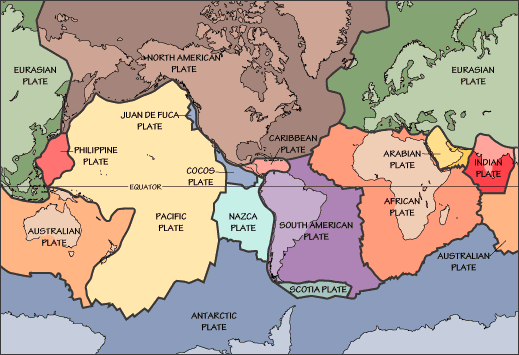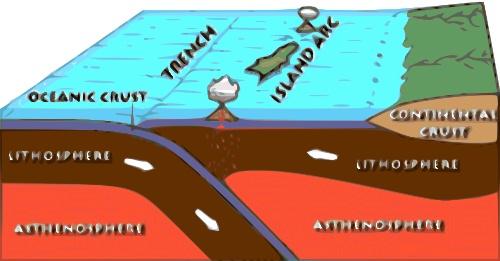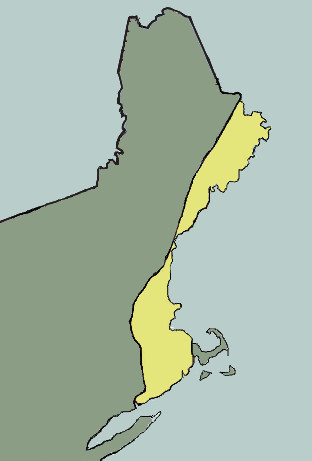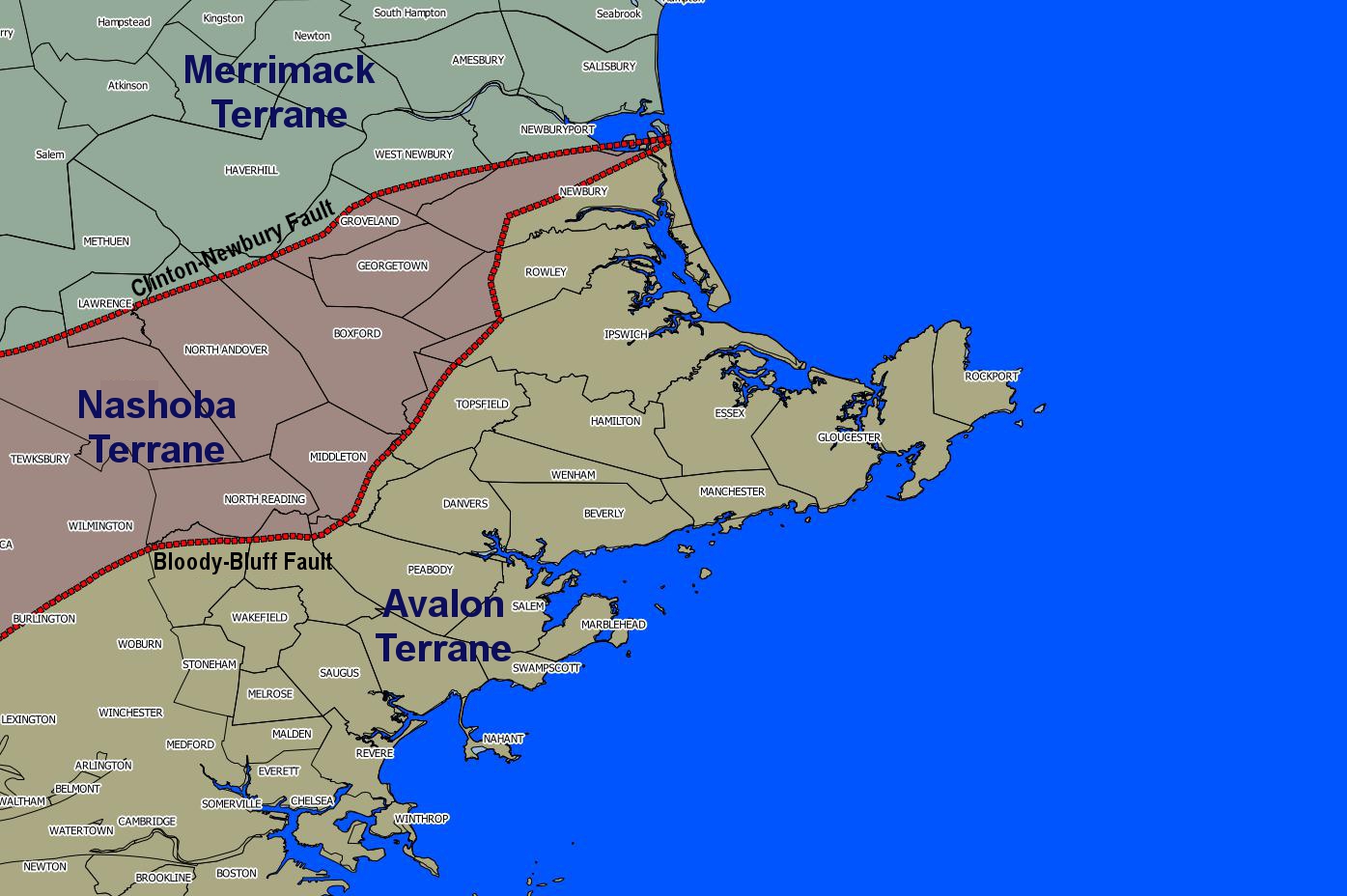Exotic New England
The bedrock under the North Shore is exotic. More precisely it is part of an exotic terrane, meaning that our bedrock has not always been part of North America. It’s origins lie off what is now the Northern coasts of Africa and South America from a time when the two continents were joined together and quite close to the South Pole. The key to understanding this seemingly strange fact is the understanding that entire continents move. Not only do they move but they collide, drift apart and slide over and under one another.
Moving Plates and Volcanic Arcs
From the time that we’ve had accurate maps of the world, geographers have wondered over the coasts of Africa and North America which seem to fit neatly together like a jigsaw puzzle. This phenomena was not investigated in any serious way until Alfred Wegner published findings in the early 20th century that certain types of fossils and geological features appeared on both sides of the ocean where the ‘puzzle pieces’ would fit together. After much more research, the theory of Plate Tectonics came into being and was widely accepted by the 1960’s and 1970’s.
The basic idea behind Plate Tectonics is that the surface of the earth (the Continents and Ocean Floor) is divided into a dozen or so thin plates that float on top of a deeper layer that is solid but flows very slowly, similar to skin that floats on top of pudding. Individual plates cross the boundaries of oceans and continents. Heated magma from the center of the earth rises, cools and falls creating a convection current under the plates causing them to move.
The boundaries between the plates are the areas where most of the earth’s crust is being actively created, destroyed or deformed. Almost all of the bedrock under the North Shore can be traced back to these boundaries. The boundaries have different names and form different types of rock depending on how they are moving. When plates are moving away from each other they have divergent boundaries, plates sliding past each other have transform boundaries and plates moving towards each other have convergent boundaries.
At some point in history, the North Shore has been in the middle of each of these types of boundaries but the convergent boundary has arguably played the largest role and is worth investigating more.
Much of coastal New England was formed as volcanic islands near the South Pole. A number of events contributed to the islands forming but perhaps the most significant was that a section of ocean crust collided with the plates that make up what is now Africa and South America. This collision likely happened far offshore so that both sections colliding were made up of oceanic crust.
When plates collide under the ocean, a special type of island often forms known as a volcanic island arc. The denser of the two plates slides underneath (subducts) the lighter plate dragging sea-water along with it. The water lowers the melting temperature of rock. This is a chemical process similar to salt lowering the freezing point of water. The melted rock rises to the surface of the plate forming islands.
Geologists first discovered evidence of this process on the Avalon Peninsula in Newfoundland and so named the island Avalon. Avalon went through several episodes of these types of collisions with the African and South American plates, each forming a new wave of volcanos and melted rock, slowly building the island in size. A number of other islands formed nearby in the same manner which have since become part of other areas far from New England, including portions of South Carolina and Florida.
Avalon moves to New England
550 to 430 million years ago
Until 550 million years ago, Avalon was firmly bound to the African and South American Plates. Around this time, something changed the direction of the plates and Avalon tore away to become an independent island. This was a slow but violent event marked by new volcanos and more melting rock.
Avalon drifted North and West, moving towards present day North America. As the island moved across the ocean, it accumulated sediments which include fossils of trilobites, a very distant cousin of Lobsters and Spiders.
Around 440 million years ago, the Western edge of Avalon is thought to have collided with Europe, which at the time was moving West on a collision course with North America. While we have only described Avalon until now, two somewhat smaller islands, Merrimack and Nashoba traveled North slightly in front of Avalon.
430 to 300 million years ago
Approximate Location of Continents 430 million years ago
Approximate Location of Continents 400 million years ago
430 million years ago, all three islands collided with each other as they approached the continental slope of North America. The three islands traveled as a unit and collided with the east coast of North America, with the edge of Avalon sliding underneath Nashoba.
This collision was a major event in the formation of the New England, reaching far inland to begin the building of the Northern Appalachian mountains. It also took a very long time, lasting around 50 million years and ending near 375 million years ago. Rocks which had formed long before were deformed (metamorphosed) and volcanoes and magma chambers formed along the northeast coast from the pressure and heat generated by the collision. Geologists have named this the Acadian mountain building event, or the Acadian Orogeny.
During Avalon’s trip North and subsequent collisions, Africa was also traveling North. Near 365 million years ago, Africa began to collide with North America.
300 million years ago to Present
Approximate Location of Continents 230 million years ago
Approximate Location of Continents 170 million years ago
By 300 million years ago, Africa had sutured itself to North America and Europe, forming the ‘supercontient’ Pangea. This collision formed the Appalachian and Alleghany mountains and is thus known as the Alleghanian mountain building event or sometimes the Appalachian mountain building event.
Avalon, Nashoba and Merrimack remained locked in the middle of Pangea until the continents began to drift apart again near 200 million years ago. Avalon was in contact with at least two, possibly three continents at the time and was torn apart in the rifting. A portion of Avalon remained glued to the North American continent and can be found throughout the coast of New England. Other parts of Avalon became glued to Europe and can be found along the coasts of England, Wales, Ireland, Belgium, France and Portugal.
Sources:










